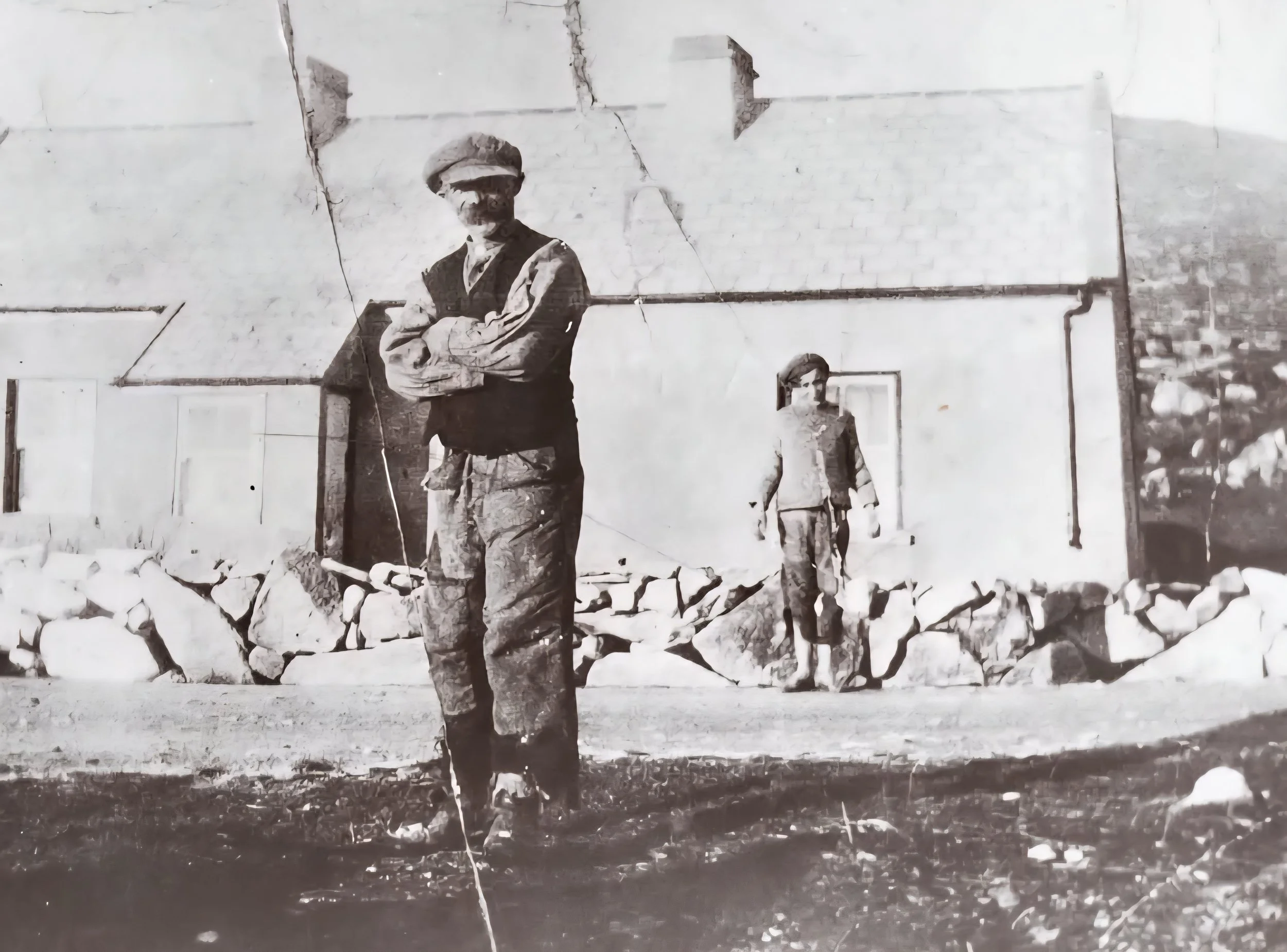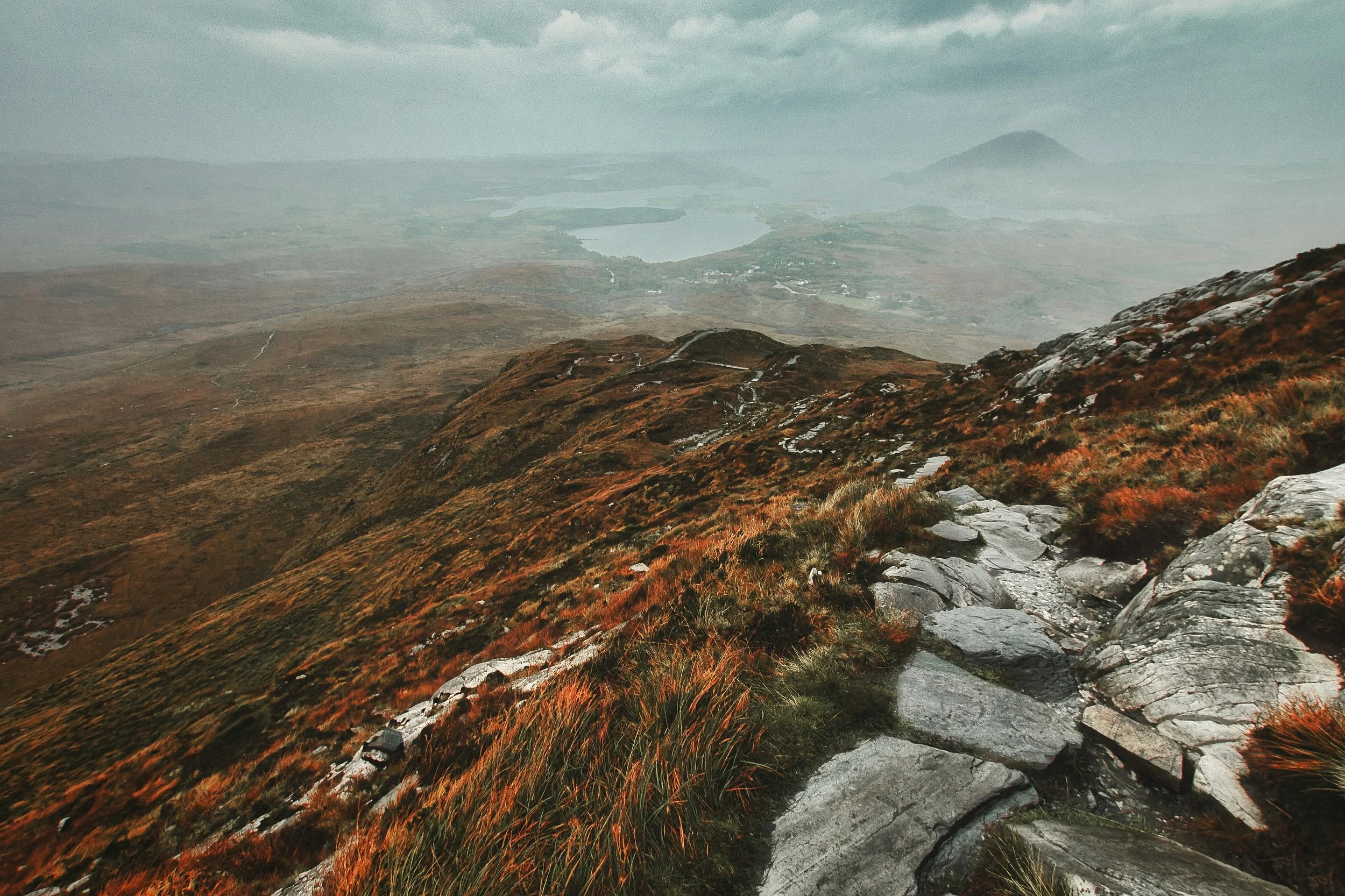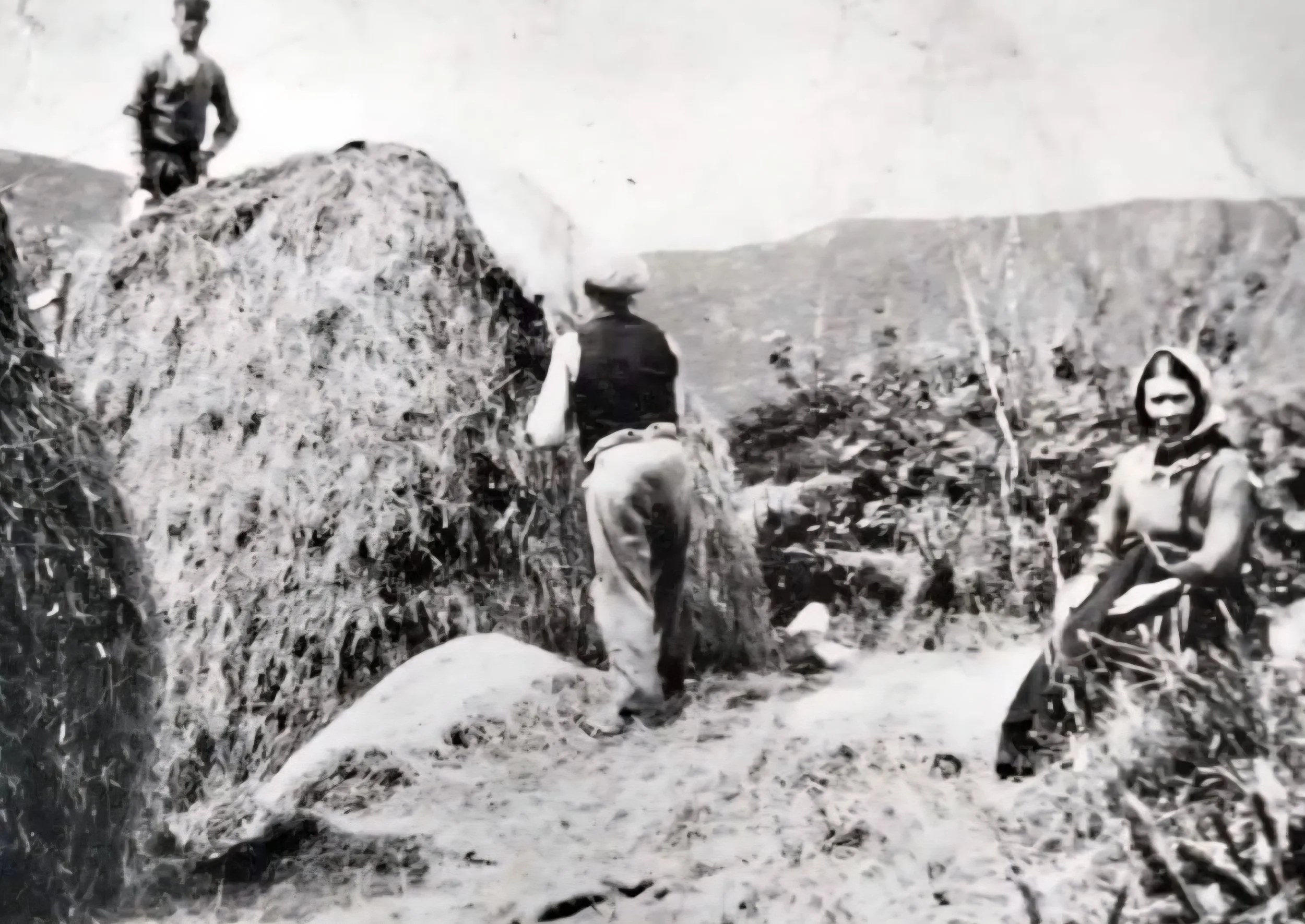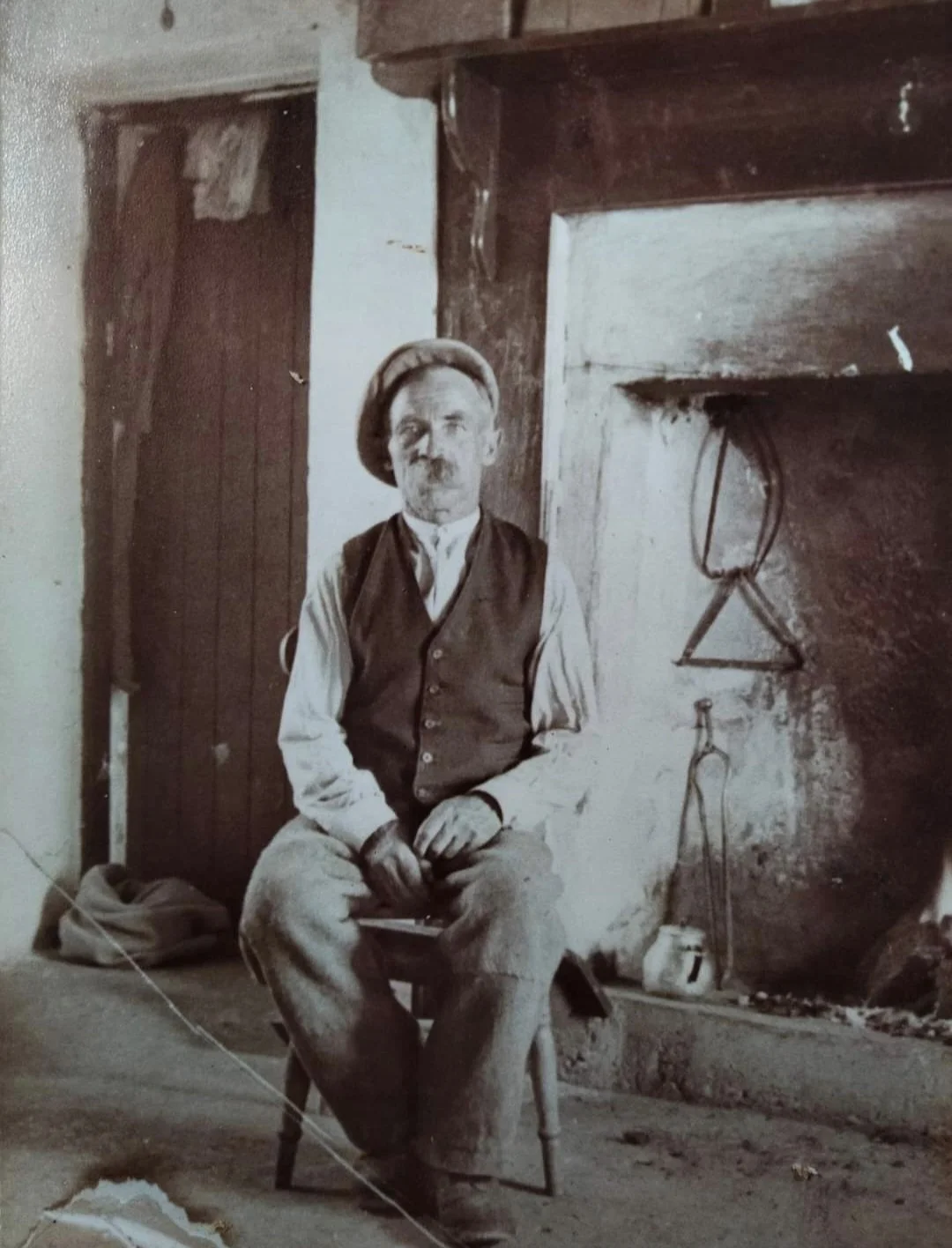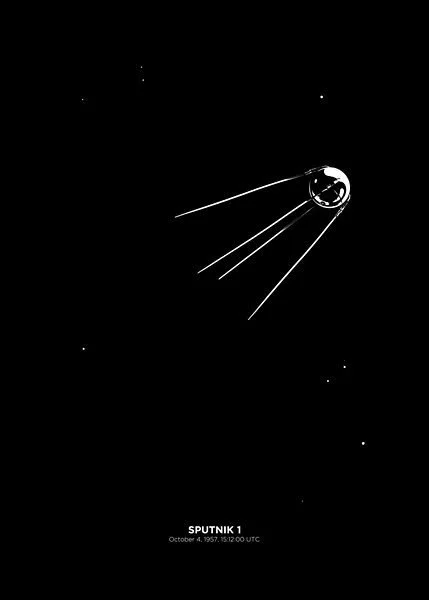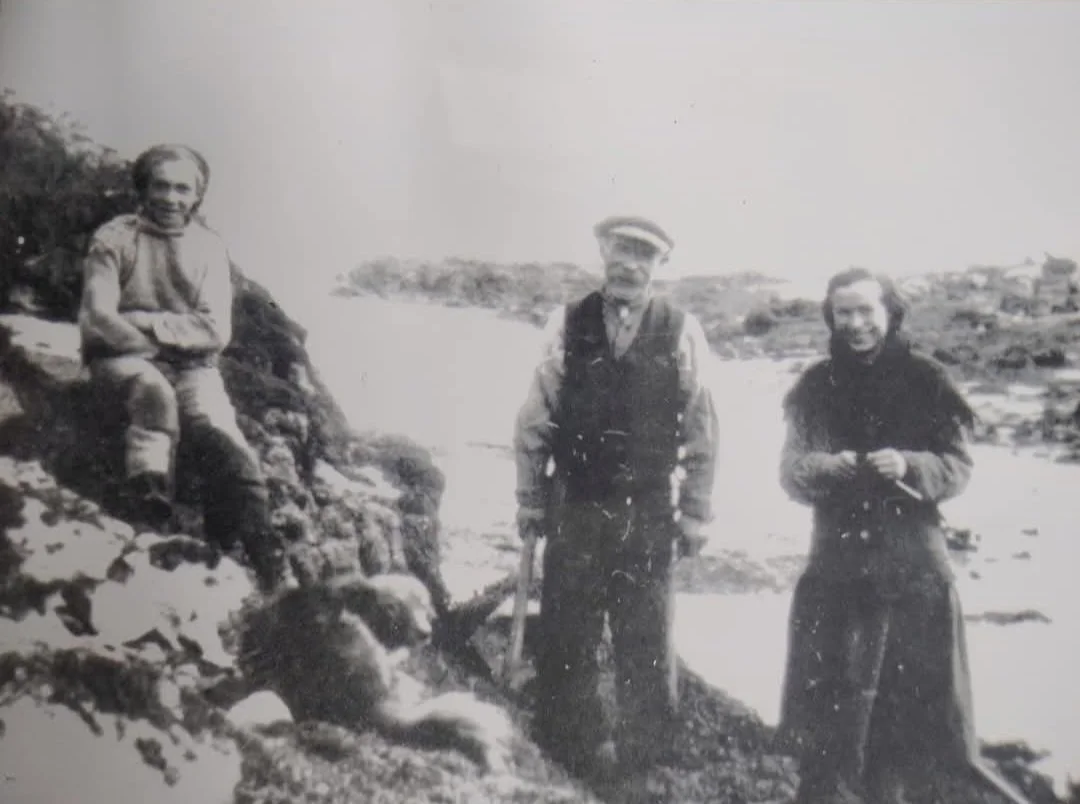Scéalta, “Stories” - Seeing into the Darkness
Na Scéalta “The Stories” - Seeing into the Darkness
Ireland has one of the richest oral traditions in Europe. For our ancestors, storytelling around the hearth at night offered respite from the challenges of day to day survival, bringing them into the hidden world of imagination, psyche, and spirit. Ireland's storytellers and poets have been revered since the earliest times. They stood at the threshold of the unseen world, carrying cultural memory, a world of magic, fairies, otherworld, wonder, and imagination.
John Pateen Johnny (my great grandfather) outside his house (An Sean teach- "the old house") in my childhood village in Connemara. His son Patrick stands behind him.
Storytelling in Connemara
The storyteller had a key place in Irish society. He had the best seat closest to the fire and shared his stories. My father recalls, from his own childhood in Connemara, the storyteller coming at night, and the people from the village gathering around the fire to hear him recount tales of heroes and the otherworld. This was in the time before electricity was available.
My father remembers sitting close to the fire as a young boy, listening. He recalls how the stories both fascinated and frightened him. Sometimes, the fire became uncomfortably hot, but he did not dare move to the darker, cooler shadows of the cottage, as it felt too far removed from the gathered company and he was afraid of what might await him there, in the darkness. He remembers times when the storyteller himself was frightened by what he had recounted, as he left the house and went out into the night, making his way home.
Red Route of Diamond Hill in Connemara National Park
The Ancestral Story
In the world of Depth Psychology and Psychotherapy, uncovering our own narrative, our own story, helps us begin to gather the scattered pieces of ourselves. No matter how tangled or imperfect our path or our story has been, we start to glimpse the wholeness of who we are—and see how, even our mistakes, are threads in the greater tapestry of our life’s unfolding. These stories serve as a way to make meaning from life. Jung wrote that “Meaning makes a great many things endurable - perhaps everything.” (1) When we make meaning from our lives, through our stories, it allows a space inside to open up, and a sense of rooted anchoring within. James Hillman, the Jungian Analyst, reminds us, “we are a storytelling species,” so the meaning that arises from the engagement with the symbolic and inner world, from the stories, lies at the heart of what it means to be human.
We also carry the stories of our ancestors—what was unspoken and spoken, what got passed down through the intergenerational line.
Healing intergenerational trauma requires us to understand what and how certain patterns in the story of our ancestors impact us today.
What meaning does that hold in the story of my life?
If we reflect on the stories of our families, what unspoken messages get passed down?
What beliefs do we hold, and what script do we unconsciously follow?
When we engage with the story, it brings conscious awareness to it, and this loosens the threads. A light of insight can shine in, awakening new possibilities away from the old script and rigid patterns. It is wonderful, too, because trauma is not the only aspect of the story that is passed down through generations. Similarly, stories of resilience, strength, courage, and profound wisdom and love are also passed down through generations, which we can reclaim for our own lives, today.
Connemara region, Co. Galway
My grandfather on top of the cock of hay, with his father and mother below.
The Old World and The New
My Great Grandfather at the hearth where my father heard the stories.
I heard a story a few months ago that has stayed with me. I was attending my lovely aunt’s funeral in the suburbs of Chicago in the US. People gathered at the Church for the funeral, men and women who left my childhood Connemara village over 50 years ago and are now living their lives in the suburbs of that city. They greeted me and members of my family, giving their condolences, and conversed in Gaeilge, the Irish language. There was something in that moment for me —a shared experience of belonging, history, and understanding. We all grew up at the foot of that same mountain. There was something about that, that I found profoundly moving.
One memorable conversation I had was with my father’s first cousin, a woman who was also from that village. She had spent over sixty years in America. She and I spoke in Gaeilge, and I was curious to hear her story.
“I was fifteen when I came to America,” she said, “I couldn’t wait to leave. I wanted adventure, to get away from the hard work of the fields. But when I arrived, everything was different – the smell, the food, the heat. In that first twenty-four hours, if I could have walked home, I would have. I was so painfully homesick. But I couldn’t go home – I had to pay back my fare and send money home.”
She then asked me, “Did you know that your great-grandfather Dadó (her grandfather) came to visit us once, here in America?”
I had no idea!
“Yes,” she said, “Aunt Mary asked him to come. ‘If I pay your fare for you, will you come?’ and to our great surprise, he said yes.”
So, my great-grandfather spent a few months in America. This was the man whose hearth my father sat at, to listen to the stories. For a man who had spent his life in a small village, it must have been an extraordinary change. I was amazed and delighted that he had the courage for the adventure. She continued her story.
Sputnik Launch, October 4th 1957
“When it was time for Dadó to go back to Ireland, I was told I had to travel with him. I was delighted, of course!” she said, “It was a chance to visit home for a while. So, the night we boarded the plane, we were seated at the front because Dadó was elderly. After some time, the pilot announced on the intercom that a historic event was happening. If anyone wanted to look out the pilot’s window, they were welcome to do so, to see the launch of the first ever satellite into space - Sputnik. So, for the next hour or so, everyone on the plane took their turn to look out the pilot’s window, to view this extraordinary event.”
And so, it went. Her journey home with my great-grandfather was a short visit. She had to return to work, in order to pay for the plane ticket that brought them back. She stayed in Chicago, married and raised a family and returned to Ireland for visits, but never to live there again.
Later on that evening, I googled the date for the Sputnik launch. It was October 4th 1957.
That image has stayed with me ever since. The image of my great-grandfather, a man rooted in the land and a very ancient way of life, sitting on a plane, witnessing a moment in history —a moment that was going to change the landscape of all our lives forever.
I am so glad I got to hear the story and to hear my own language spoken in the suburbs of a city in America, by the people of my village who had left so many years before.
It was a beautiful reminder to me that our lives are always woven between past and future. My great-grandfather carried the old world within him, and in that moment, he glimpsed the beginning of a new era. It was a reminder that we stand at the meeting place of what has come before us and what is yet to be born. We need both to weave the tapestry of our lives and to come to know ourselves.
My great grandfather with his son and daughter (it was her daughter (now in her 80s) that shared the story of the trip home)
References :
(1) Jung, Man and His Symbols, p. 76. 